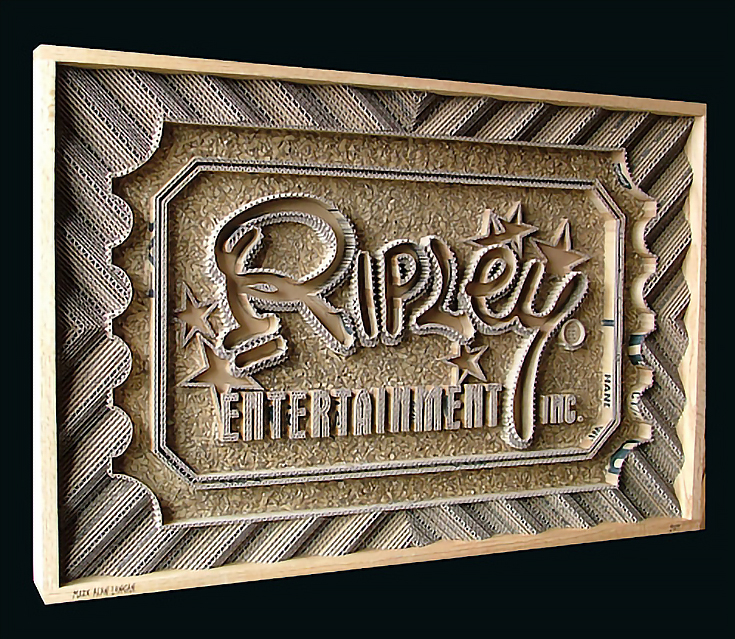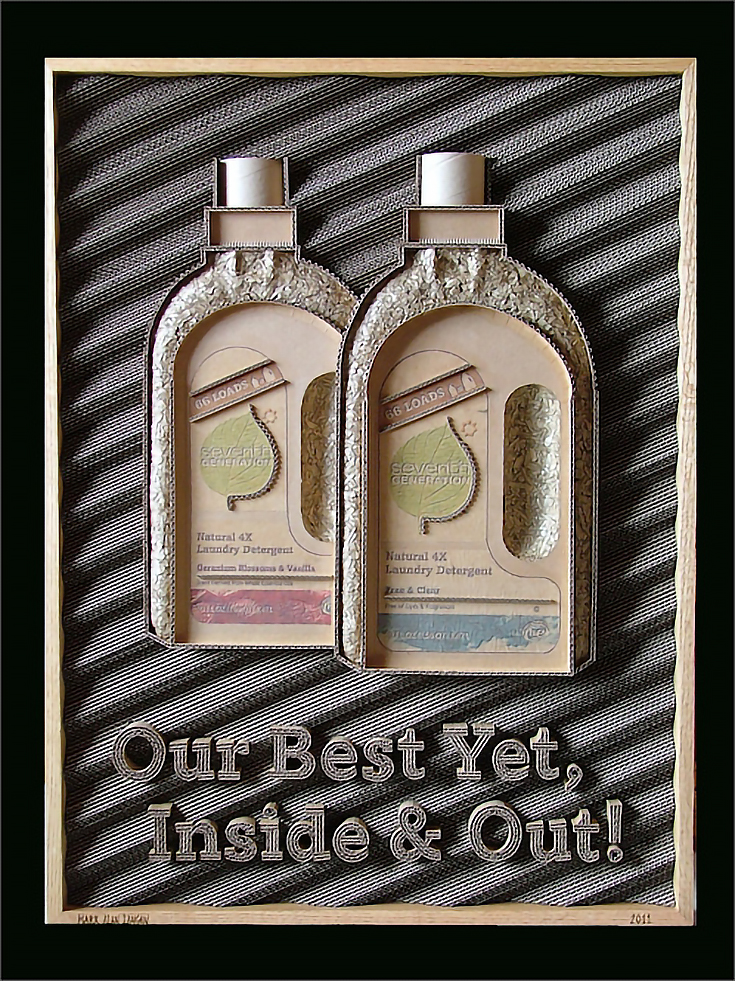Mark Langan comes from a long line of artists. His great, great grandfather, William Langan, was a cartoonist. His great uncle, Irwin Langan, was an illustrator. And his aunt, Fredreen Bernatovicz, is a watercolor artist. But it wasn’t until 2003, after 20+ years in the transportation industry that he officially took his talent seriously and decided to devote more time to becoming a professional artist.
To date, he has created unique, cardboard logos for corporate clients such as Kellogg’s, Propr Clothing, and Sycamore Containers; and has even had his work displayed at Ripley’s.
Alyice: You create amazing three-dimensional sculptures using corrugated boxes. How did you come up with this idea?
Mark: As an artist I am always looking at things from a different perspective even with previous traditional mediums.
While breaking down boxes for trash day I happened to notice the wavy medium (called flute) that is sandwiched between the two paper layers of the corrugated box. That layer gives the box its strength.
I thought, to myself, that it had the potential of becoming some very creative and artistic sculptures so I asked my neighbor, who was unpacking from a move at the time, to save his boxes for me. When I received them, I started slicing and creating my first interpretive work.
I was so pleased with the results that I took it to higher levels by marketing the sales to those in the related industry.
Alyice: What is the most challenging part about working with corrugated boxes?
Mark: Just creating. There is normally upwards of 1,500 individual cut pieces in each and every sculpture. With a drawing you can erase an error, on a canvas you can paint over, but with my pieces it is almost impossible to make a correction once the corrugated material is glued down.
It is very unforgiving!
I try to listen to what people are saying and take their comments to heart by implementing their suggestions in my pieces. In a recent Campbell’s soup can rendition (in I.D. magazine), for instance, I contacted Campbell’s and The Warhol Museum in Pittsburgh. I even started looking at the galleries Warhol himself personally had used on the West Coast. . . you just never know.
Alyice: Are you picky about the condition of the boxes you receive?
Mark: I first and foremost like larger boxes versus smaller ones. It helps to cover that much more distance on the canvas (frame). While using a sharp razor knife, and after being cut, it is almost impossible for anyone to tell if I used a new box or a used box.
I can use fairly anything, and still do, but I wouldn’t use a box if it was saturated with water. That takes away from the integrity of the glue holding it together and creates unflattering warps.
I have stacks of boxes that I keep for specific projects. Of course not all are in pristine condition, but then again, none of them carried decaying food either. . . that would be unsanitary.
Alyice: Can you share your process with us?
Mark: Everything I do is first conceived the old fashioned way with pencil and paper. I’ve worked with the material so long now that I literally don’t need to mock anything up or build a large demo of it.
I will sometimes draw something two or three times until I am satisfied. Then I refine those drawings and place to scale on paper so they are ready to transfer over. Once the frames are built, the artwork is transferred over using graphite paper.
You have probably heard this many times from others but it is true for me, too. I will sometimes have visions or art I have created in my dreams. I sometimes will have an idea come out of nowhere for which I will write down and save a later date.
Alyice: You normally frame your artwork with an oak frame. Is there any particular reason why you stick to oak?
Mark: I use the hardwood Oak because of a number of reasons. Some of those being that it accepts stains well, it is a strong wood and does not tend to warp or twist, and because of its availability.
Corrugated boxes are very strong and when you laminate piece onto piece it can pull in unusual ways and with some rather unpleasant results. I actually nail a ply backing to my frames that is received from a dado cut/kerf I make in the back of the frame. Panel is then glued and nailed into place providing for a sturdy base.
Although Oak may not be the preference to the eco-friendly, the ply backing is, These I salvage from home building sites. These are the cast offs (luan underlayment) from flooring projects that are too small for the Tradesmen to use but perfect for my application. Again, once cut, sanded and fitted there is absolutely no way one would know it was recycled unless I tell them.
Alyice: You’ve been able to land many commissions with manufacturing, packaging, and recycling industries. How does working on a project for these establishments differ from working on a personal project?
Mark: Corporate work (commissions) outweigh private commissions about ten to one.
It’s always good to be able to associate yourself with corporate commissions.
These days with economy worries it helps to know that you can work with someone that has a budget for art. Art is a luxury. . . being a want for the most part and not a need.
Not to contradict myself here, but I have come to also find that there are businesses that look quite the opposite of art. They know that it is a strong marketing tool and when I, as an artist, can create something three dimensional and bring to life a graphic it can be quite powerful for them. Even better yet is when their material (boxes) is incorporated into the art.
Many times corporate pieces are placed in lobbies for all to see. . . It’s a no brainer for me, the art is actually the best salesperson I could have.
While working with either an individual collector or a corporate commission I always create loose drawings for them and request their input. How could it not? It makes for a good sense that I get their feedback. I will also ask them questions like, “What do you like of this particular piece?” or “What don’t you like?”
I also take progression pictures and will forward them to my client so they can see the art come together right before their eyes.
Alyice: One of your goals, when you began this project, was to make people aware of the power of recycling and reusing already made materials. Have you been able to see difference?
Mark: Well, I guarantee you that I have personally saved many many boxes from landfill. Have I made a huge dent to waste reduction? Of course not, but at least it is something rather than nothing.
It would be absurd for me to say I am making a large difference as I am not the most perfect “green” person I know. I like to create sculptures that are aesthetically pleasing and will stay that way.
My art is really eco-friendly but that was not the intent at all and sometimes I do shy away from using those almost cliché buzz words.
My goals are to get people to smile first, then at least get them talking about it and they do.
Art, I always feel, should make one think and trigger or stir some emotion.
Alyice: Aside from creating your sculptures, is there anything else you find difficult about being an artist?
Mark: I spend a great deal of time marketing. I feel that most artists overlook marketing and spend too much time in the studio.
Alyice: What’s been your greatest success as an artist?
Mark: There have been many I must say.
I get so jazzed all the time by how many “big names” I have acquired as clients over such a short time and some of the press as a result of my art. It never ceases to amaze me how my art can “connect” with so many people and the responses I get with it while on display. People who normally are not that particularly fond of being art lovers are drawn to it because it’s just something out of the norm.
How many artists can say they have created work personally for the likes of Hollywood Actor David Arquette? Or have the admiration of Ripley’s by having them acquire and display two pieces in their museums?
And not too long ago I was contacted by a Professor at the University of Cairo because he wanted me to assist him in making a textbook on my specific art form. Publications such as Perspective (architecture), Allure, and most recently w/Interior Design keep me focused. . . knowing I’m on the right track allows me to give it my best.
To learn more about Mark’s art, visit his website at www.langanart.com.
This post may contain affiliate links.





